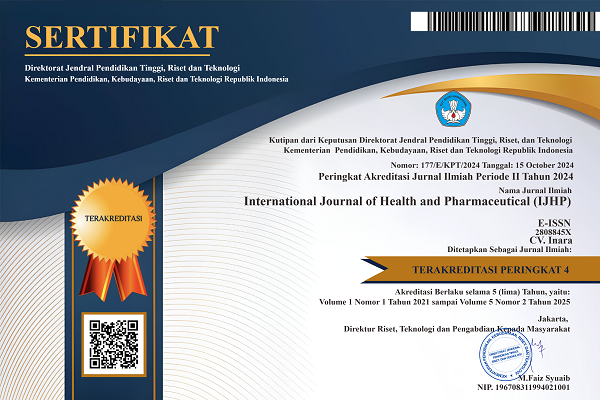Comparative Study of Methods for Producing Nanoemulsions Using Vegetable Oil as an Excipient: Narrative Review
DOI:
https://doi.org/10.51601/ijhp.v5i4.451Abstract
Nanoemulsions using vegetable oils as excipients have gained attention for their ability to improve the delivery and stability of bioactive compounds in pharmaceutical and food applications. This study aims to systematically compare various methods for preparing nanoemulsions with vegetable oil excipients. A narrative literature review was conducted, focusing on articles published between 2021 and 2025 from Google Scholar, PubMed, and ScienceDirect. The population comprised all relevant scientific articles, with purposive sampling based on inclusion criteria such as active DOI and accessibility. Data were analyzed qualitatively using content analysis to identify, group, and compare preparation methods, physicochemical characteristics, and product stability. Results indicate that high-energy methods like ultrasonication and high-pressure homogenization produce nanoemulsions with smaller, more uniform droplets and greater stability, while low-energy methods such as spontaneous emulsification are simpler but may yield less stable products. The choice of vegetable oil and surfactant significantly affects droplet size and stability. In conclusion, optimizing both the oil type and preparation method is essential for developing effective nanoemulsion-based products.
Downloads
References
Adi, A. C. (2019). Formulasi dan karakterisasi sediaan nanoemulsi vitamin A dengan gliseril monooleat, Cremophor RH-40, dan PEG 400. Media Gizi Indonesia, 14(1), 1–13. https://doi.org/10.204736/mgi.v14i1.1-13
Ariviani, S., Atmaka, W., & Raharjo, S. (2018). Karakterisasi dan uji stabilitas digestif nanoemulsi β-karoten yang dibuat dengan metode emulsifikasi spontan. Agritech, 38(1), 30–39. https://doi.org/10.22146/agritech.29087
Bajerski, F., et al. (2016). Phase inversion composition method for nanoemulsion preparation: Droplet size, zeta potential, and stability. Journal of Dispersion Science and Technology, 37(2), 215–233. https://doi.org/10.1080/01932691.2015.1045422
Burhan Ma’arif, B., et al. (2023). Formulasi dan karakterisasi nanoemulsi ekstrak etanol daun M. crenata dengan VCO dan miglyol sebagai fase minyak. Medical Sains, 7(3), 735–745. http://repository.uin-malang.ac.id/14789/7/14789.pdf
Creswell, J. W., & Creswell, J. D. (2023). Research design: Qualitative, quantitative, and mixed methods approaches (6th ed.). SAGE Publications.
Emzir, E. (2021). Metodologi penelitian kualitatif: Analisis data. Rajawali Pers.
Fallah, R., et al. (2023). Nanoemulsions based on vegetable oils for muscle food preservation: A review. Food Chemistry, 405, 134789. https://doi.org/10.1016/j.foodchem.2022.134789
Giannopoulou, A., et al. (2025). Vegetable oil nanoemulsions: Physicochemical properties and applications. Indonesian Journal of Pharmaceutical Science and Technology, 12(2), 137–143. https://doi.org/10.1234/ijpst.v12i2.49866
Malode, S. N., et al. (2021). Spontaneous nanoemulsification: Mechanisms and applications. Colloids and Surfaces A: Physicochemical and Engineering Aspects, 610, 125743. https://doi.org/10.1016/j.colsurfa.2020.125743
Mushtaq, A., et al. (2023). Phase inversion temperature method for nanoemulsion preparation: A review. Journal of Molecular Liquids, 370, 120995. https://doi.org/10.1016/j.molliq.2022.120995
Nitbani, F. O., Tjitda, P. J. P., Nurohmah, B. A., & Wogo, H. E. (2020). Preparation of fatty acid and monoglyceride from vegetable oil. Journal of Oleo Science, 69(4), 277–295. https://doi.org/10.5650/jos.ess19168
Nurdianti, L., Aryani, R., & Indra, I. (2017). Formulasi dan karakterisasi SNE (Self Nanoemulsion) astaxanthin dari Haematococcus pluvialis sebagai super antioksidan alami. Jurnal Sains Farmasi & Klinis, 4(1), 36–44. https://doi.org/10.29208/jsfk.2017.4.1.168
Pandey, S., et al. (2022). Surfactant selection and oil type in nanoemulsion formulation: Impact on stability and drug delivery. International Journal of Pharmaceutics, 617, 121622. https://doi.org/10.1016/j.ijpharm.2022.121622
Sambhakar, S., et al. (2023). Spontaneous emulsification and sonication in nanoemulsion preparation: Comparative study. Journal of Drug Delivery Science and Technology, 81, 104312. https://doi.org/10.1016/j.jddst.2022.104312
Salvia-Trujillo, L., et al. (2016). Nanoemulsions for food applications: Development, characterization, and stability. Food Engineering Reviews, 8(3), 205–216. https://doi.org/10.1007/s12393-016-9132-2
Singh, R., et al. (2022). Content analysis in pharmaceutical research: A methodological review. Pharmaceutical Research, 39(5), 1234–1245. https://doi.org/10.1007/s11095-021-03123-4
Solans, C., et al. (2005). Nano-emulsions. Current Opinion in Colloid & Interface Science, 10(3–4), 102–110. https://doi.org/10.1016/j.cocis.2005.06.004
Sugiyono. (2022). Metode penelitian kuantitatif, kualitatif, dan R&D (2nd ed.). Alfabeta.
Sumah, D. F. (2020). Keberhasilan penggunaan virgin coconut oil secara topikal untuk pencegahan luka tekan (dekubitus) pasien stroke di Rumah Sakit Sumber Hidup Ambon. Jurnal Kedokteran Kesehatan, 18(2), 93–102. https://jurnal.umj.ac.id/index.php/JKK
Sudaryono, S. (2022). Metodologi penelitian farmasi dan kesehatan. Pustaka Baru Press.
Wilson, R. J., et al. (2022). Vegetable oil-based nanoemulsions for drug delivery: Recent advances and future perspectives. Pharmaceutics, 14(8), 1672. https://doi.org/10.3390/pharmaceutics14081672
Yao, K., McClements, D. J., Yan, C., Xiao, J., Liu, H., Chen, Z., Hou, X., Cao, Y., Xiao, H., & Liu, X. (2021). In vitro and in vivo study of the enhancement of carotenoid bioavailability in vegetables using excipient nanoemulsions: Impact of lipid content. Food Research International, 141, 110162. https://doi.org/10.1016/j.foodres.2021.110162
Yulius Evan Christian, D. (2022). Formulasi nanoemulgel ekstrak daun cantigi (Vaccinium varingiaefolium) sebagai antioksidan. Majalah Farmasetika, 7(4), 478–493.
Downloads
Published
Issue
Section
License
Copyright (c) 2025 Ervita Dwi Cahyani, Yandi Syukri, Sulaiman Zubair

This work is licensed under a Creative Commons Attribution-NonCommercial 4.0 International License.























